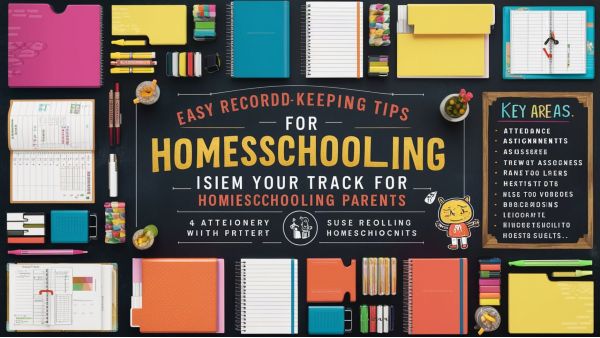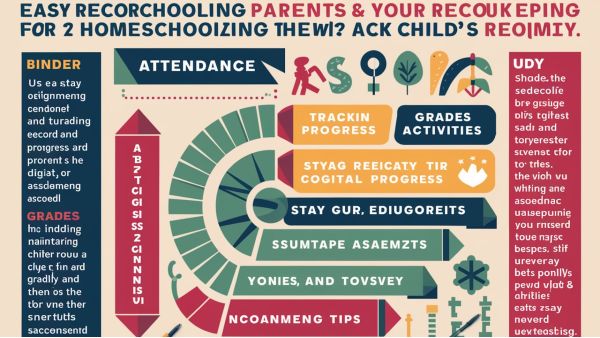Maintenance of records in homeschooling is sometimes cumbersome. Parents have a tendency to keep many roles. All that is required is to have a good record keeping system in place to make homeschooling smooth. It also equips students with future academic direction. An effective structure facilitates both the legal need and the learning objective. Records help parents to 9feel more confident, 9in control.
The Significance of Record Keeping in Homeschooling
Homeschooling is accompanied by special obligations. You end up to be a parent and a teacher. Monitoring is not a choice. It indicates the way your child learns and develops. It shows that you adhere to state guidelines. Documentation allows gaps in learning to be detected. It also honors success. Records also give more time to reflect and plan.
Advance your career with must-have skills and explore AI in education. Try live tutoring platforms, manage homeschooling multiple kids, and find affordable homeschool curriculums. Explore more at Study.com.
Simple Tools You Require in Keeping Records
Learn by using easy tools. A notebook and folders can do a lot of things. Online tools are even more effective. There is greater flexibility with spreadsheets or record keeping apps. Take what is convenient to your routine life. Include it in your everyday life. It is possible to upgrade once needs increase. You do not have to have fancy supplies to get started.
The physical Tools
- Notebooks
- Binders
- Printed checklists
- File folders
Technology Enabled Tools
- Google Sheets
- Trello
- Evernote
- Homeschool Tracker
Choose instruments that are comfortable to handle. Complex systems tend to crash. When you are simple, you are solid. Tools simple to use have better chances of becoming a daily activity. An allocating system to suit your lifestyle keeps you on track. Paper or tech the aim is everyday usage.

Record Keeping Requirements
Every homeschooling experience is unique. Some still records are universal. Have them at the ready so you do not have a future stress. These are attendance schedules and daily notes. Ask to attach lesson plans and test results. Save work samples in the stores. Also maintain notes on evaluation and progress. Good records facilitate easy reporting at a later stage.
Daily Logs:
Day to day records record what your child did every day. Write brief notes. Add topics included and resources exploited. Include field work and practical activities. This also contributes towards a complete picture of learning. When reviews are done weekly or on a monthly basis, these logs become useful.
Records on Attendances
In some states, they request attendance tracking. It can also help foster discipline even when not necessary. Enter learning days in a calendar. Include additional comments when you need to. Color codes or simple checkboxes are fine. This assists in case the laws alter later or high school.
Lesson Plans
Teacher lesson plans are used. They also demonstrate planning. Outlines are effective when they are simple. Add subject objectives and materials. Alternatively, you can enumerate books and websites. This is useful should you want to repeat the lesson in future.
Grades and Tests Scores
Tests quizzes and graded assignments are recorded. Make scores to be seen. You will require them in transcripts. Grading can assist parents and children to monitor improvement. Select transparent ways of grading.
Work Samples
Samples are improved with time. Select the work in other subjects. Include early and more recent examples. Consider written work of art and projects. This clarifies the learning process. Apply photos as heavy project.
Progress Reports
Write periodic reports. Measure improvement using them. List your strong points and the areas to which attention is required. These enable you to strategize the next course of action. Portfolio reviews are enhanced by the use of reports. Make them short, yet precise.
Sorting of Your Records
Everything is easier with good organization. Decide on a form of format and maintain that form. You may employ binders or electronic folders. Order the records either in order of date or according to topic. Develop a schedule of updates. Reviews should be done weekly. This maintains a record up-to-date and accurate. Clean systems are time-saving systems.
File Naming Hints
- Filename dates
- Subject labels should be concise
- Include grade tags
- Example: Math_Grade4_Sept2025.pdf
Color Coding
Fast sorting by means of color-labels. Choose one color against each subject. It enables children and parents to locate files quickly. Put up sticky notes or labels on the folders. This applies to both paper based and electronic records.
Using WordPress in Record Keeping
WordPress assists homeschoolers to keep track of progress online. Make individual pages or posts per student. Lump items together with categories. Password allowed data security. WordPress is also compatible with the plugins of additional features. It is possible to share progress with a family or to hide it.
Ordered and Unordered Lists
WordPress lets you create easy lists.
Ordered List Example:
- Open WordPress dashboard
- Click on Pages
- Add a new page
- Write your record
- Click publish or save draft
Unordered List Example:
- Lesson plans
- Attendance logs
- Reading lists
- Progress charts
Such lists render your data clear and ordered. They assist in rapid reading and updating no problems. They may be also printed out to be reviewed.
State Guidelines and Legal Requirements
The homeschool laws vary in each region. See what your state requires. Others seek annual testing. Others demand certain reports. Save or keep any submissions. Be sure to frequent your state education site. Make sure you are up to date with changes in rules. Being aware of your rights prevents stress in the future.
Pros and Cons of Digital vs Paper Records
| Feature | Digital Records | Paper Records |
|---|---|---|
| Storage | Easy to store and search | Needs physical space |
| Security | Needs backups | Prone to damage |
| Sharing | Easy to email or print | Hard to duplicate |
| Flexibility | Allows quick edits | Not easy to change |
| Cost | May need software | Uses stationery |
Select what suits you according to your comfort. You may also combine the two kinds. The flexibility is provided by the hybrid systems. Take logs on digital and samples on paper.
Resources Links internals
Find more homeschooling tools at instituteinfo where you can find guides and updates.
Pointers to Remain Conistthreshold with Record Keeping
Updates on a daily basis should become a habit. Be reminded in case necessary. Check your system once per month. Ask your kid to assist in running simple logs. Praise yourself when you are organized. The formula to success is simplicity. Remain optimistic and avoid missed updates. Little by little on a daily basis makes a great difference.
Hints on Bonus to Make You More Motivated
Begin with week goals. Do not wait till the month end. Apply visual monitors. Tell your friends about your victories. Connect with online homeschoolers groups. You get motivated when you experience progress. Use phone reminders. Make record keeping a brief activity.
Creation of a Yearly Portfolio
Collect the best of all subjects. Put photos on projects. Take some short notes on each section. Put in a cover sheet and table of contents. Include attendance records and testing results. Have it all in one folder. Print out on demand (assessments).
Developing a Digital Back-up
Have a spare copy at all times. Save in the cloud such as Google Drive. Folders should be named year, grade. Create backup reminders on a monthly basis. Send emails to yourself. Have one offline backup in a USB disk. This guards against data loss.
Free Templates of Homeschool Records
Templates are available at many websites. You are also able to come up with yours. Green Docs or Word. Begin with the elementary. Add what suits your fashion. Prepare log-tests and reading-lists templates. Use them eight months at a time.
Inclusion of the Children in Documentation
Allow your children to assist in simple tracking. They can keep reading records or write field trips. This develops responsibility and awareness. It also enables the children think over what they are taught. You impart life skills in the exercise. Use stickers or drawing and make it fun. Have them be proud of their records.

Boost your learning with these free online platforms with certificates and learn coding at home step by step. Improve study habits using note-taking strategies and memorization techniques.
Visual Charts and Calendar Use
Record keeping becomes more involving with the use of visual tools such as charts and calendars. They indicate patterns of learning glance-wise. Subjects or attendance, use wall charts. Attempt printable calendars to aim and assess sessions. These instruments increase the clarity and enable children to gauge their development. The pictorials create a more thrilling and comprehensible progress.
Establishing Subject Specific Folders
Having by topic makes searching easy. Create a folder of every subject. Write notes and plans tests in each. This aids in concentration and monitoring of objectives. Name every folder. Add subtopics dividers. This is a time-saving approach when it comes to reviews. It also makes students to be ready in the future academic filing.
High school Records Management
High school records require special attention. Maintain good records of transcripts and grades. Credits taken by subject. Record extracurriculars, and volunteer work. Colleges would like to know this information. The sooner the better you won!t be in a rush. Add test scores such as SAT or ACT. Good records are beneficial in the college application process and scholarships.
Defending Privacy on Records Online
Digital tools are powerful and safety is an issue. Access files with good passwords. Keep the records on an encrypted platform. Sharing it should exist with family only. Never use a sharing link. Continuously update software in order to avoid data loss. Storing copies at different locations also assists. Educate children regarding online safety.
Weekly Record Goals
Divide your record keeping into weekly targets. Revise a topic daily. Make the update brief. This tendency gives freshness. Simply arrange all that on Friday. Notate what you touched and what you need to do. A weekly frequency eliminates stress. It also enables you to be accountable and consistent.
Monitoring Field Trips and Special Events
The significance of field trips as teaching method. Take note of where you have been and what you have learnt. Take photographs when you can. Keep brochures and tickets in a folder. Include brief comments along with your child. Give maps or drawings. Such experiences are lessons. They bring lightness and diversity in your homeschool records, as well.
Tailoring to Your System Through Time
Your system needs to expand as you do. Today what works will not be working next year. Look at your arrangement every term. Ask what feels simple and what seems hard. Quit what drags. Include instruments that would assist you in staying on track. Personalizing is energy economical and enhances outcomes.
FAQs On Homeschool Record keeping
Q1. Do I have to save all the worksheets ?
No. Retention samples which improve. Select some of each.
Q2. How many years are homeschool records to be kept ?
At least 2-5 years. Other states might demand more. Records in high school should remain longer.
Q3. Do I need mobile apps in record keeping ?
Yes. Logging is easy on many apps. Select one that makes copies of your data.
Q4. What happens in case of falling behind with records ?
Keeping up to date with statistics. Retreat as far as you may. Never allow any delay to accumulate.
Q5. Are schools and states willing to accept digital records ?
Yes. Only make sure that they are legible and printable. Digitization is becoming prevalent.
Concluding Remarks
Keeping records does not have to be difficult. Be plain and ordinary. Apply what suits you. Combine online and print when necessary. Engage your children. Learn more and adapt. The following are some tips to make homeschooling a confident experience. Begin with little and expand your system. And you will be glad you did. An open system implies fewer nerves and more happiness in study.

